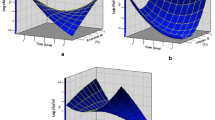Abstract
The heat-based spray drying process generating the highest level of advanced glycation end-products (AGEs) in the infant formula processing was set as a control point from which the levels of AGE markers, N-carboxymethyllysine, 5-hydroxymethylfurfural, and fluorescence intensity, can be mitigated. We optimized the parameters, including inlet temperature, feeding rate, and aspirator rate during spray drying, and alternatively optimized food additives, including pyridoxine hydrochloride, dl-α-tocopheryl acetate, and l-carnitine. Using response surface methodology, the optimal condition based on our experimental condition for the inlet temperature, pump rate, and aspirator rate were 148.7 °C, 342.4 mL/h and 28.6 m3/h, respectively, and the optimal conditions of pyridoxine hydrochloride, dl-α-tocopheryl acetate and l-carnitine were 0.99 mg/100 g dry mass (DM), 8 mg/100 g DM and 20.4 mg/100 g DM, respectively. These results suggest that AGEs can be mitigated by controlling the parameters and optimizing the addition of food additives during the spray-drying process.


Similar content being viewed by others
References
Ames JM. Determination of Nɛ-(carboxymethyl) lysine in foods and related systems. Ann. NY. Acad. Sci. 1126: 20–24 (2008)
Birlouez-Aragon I, Pischetsrieder M, Leclere J, Morales F, Hasenkopf K, Kientsch-Engel R, Ducauze, CJ, Rutledge D. Assessment of protein glycation markers in infant formulas. Food Chem. 87: 253–259 (2004)
Booth AA, Khalifah RG, Hudson BG. Thiamine pyrophosphate and pyridoxamine inhibit the formation of antigenic advanced glycation end-products: comparison with aminoguanidine. Biochem. Bioph. Res. Co. 220: 113–119 (1996)
Box GE, Wilson K. On the experimental attainment of optimum conditions Breakthroughs in Statistics (pp. 270–310): Springer (1992)
Burton G, Ingold K. Autoxidation of biological molecules. 1. Antioxidant activity of vitamin E and related chain-breaking phenolic antioxidants in vitro. J. Am. Chem. Soc. 103: 6472–6477 (1981)
Burton G, Ingold K. Vitamin E: application of the principles of physical organic chemistry to the exploration of its structure and function. Accounts Chem. Res. 19: 194–201 (1986)
Burton H. Reviews of the progress of dairy science: the bacteriological, chemical, biochemical and physical changes that occur in milk at temperatures of 100–150° C. J. Dairy Res. 51: 341–363 (1984)
Cai W, He JC, Zhu L, Chen X, Zheng F, Striker GE, Vlassara H. Oral glycotoxins determine the effects of calorie restriction on oxidant stress, age-related diseases, and lifespan. Am. J. Pathol. 173: 327–336 (2008)
Chen XD, Mujumdar AS. Drying technologies in food processing: John Wiley & Sons. (2009)
Chiarelli F, de Martino M, Mezzetti A, Catino M, Morgese G, Cuccurullo F, Verrotti A. Advanced glycation end products in children and adolescents with diabetes: relation to glycemic control and early microvascular complications. J. Pediatr. 134: 486–491 (1999)
Diez R, Ortiz M, Sarabia L, Birlouez-Aragon I. Potential of front face fluorescence associated to PLS regression to predict nutritional parameters in heat treated infant formula models. Anal. Chim. Acta 606: 151–158 (2008)
Drusch S, Faist V, Erbersdobler H. Determination of Nϵ-carboxymethyllysine in milk products by a modified reversed-phase HPLC method. Food Chem. 65, 547–553 (1999)
Elversson J, Millqvist‐Fureby A, Alderborn G, Elofsson U. Droplet and particle size relationship and shell thickness of inhalable lactose particles during spray drying. J. Pharm. Sci. 92: 900–910 (2003)
Fenaille F, Parisod V, Visani P, Populaire S, Tabet JC, Guy, PA. Modifications of milk constituents during processing: A preliminary benchmarking study. Int. Dairy J. 16: 728–739 (2006)
Ferrer E, Alegrıa A, Farre R, Abellan P, Romero F. High-performance liquid chromatographic determination of furfural compounds in infant formulas: Changes during heat treatment and storage. J. Chromatogr. A 947: 85–95 (2002)
Gülçin İ. Antioxidant and antiradical activities of l-carnitine. Life Sci. 78: 803–811 (2006)
Henle T, Walter H, Klostermeyer H. Evaluation of the extent of the early Maillard-reaction in milk products by direct measurement of the Amadori-product lactuloselysine. Eur. Food Res. Technol. 193: 119–122 (1991)
Horwitz, W. (Ed.). Official methods of analysis of the association of official analytical chemists (Vol. 534): AOAC, Arlington, VA, Washington DC. (1980)
Jaeger H, Janositz A, Knorr D. The Maillard reaction and its control during food processing. The potential of emerging technologies. Pathol. Biol. 58: 207–213 (2010)
Jain SK, Lim G. Pyridoxine and pyridoxamine inhibits superoxide radicals and prevents lipid peroxidation, protein glycosylation, and (Na+ + K+)-ATPase activity reduction in high glucose-treated human erythrocytes. Free Rad. Bio. Med. 30: 232–237 (2001)
Jung HL, Nam MH, Hong CO, Pyo MC, Oh JG, Kim YK, Choi, YY, Kwon JI, Lee KW. Optimization of anti-glycation effect of l-carnitine, pyridoxine hydrochloride and dl-α-tocopheryl acetate in an infant formula model system using response surface methodology. Korean J. Food Sci. Technol. 47: 95–102 (2015)
Khalifah RG, Baynes JW, Hudson BG. Amadorins: novel post-Amadori inhibitors of advanced glycation reactions. Biochem. Bioph. Res. Co. 257: 251–258 (1999)
Kurozawa LE, Morassi AG, Vanzo AA, Park KJ, Hubinger MD. Influence of spray drying conditions on physicochemical properties of chicken meat powder. Dry. Technol. 27: 1248–1257 (2009)
Le Man H, Behera S, Park H.. Optimization of operational parameters for ethanol production from Korean food waste leachate. Int. J. Environ. Sci. Te. 7: 157–164 (2010)
Maa YF, Costantino HR, Nguyen, PA, Hsu CC. The effect of operating and formulation variables on the morphology of spray-dried protein particles. Pharm. Dev. Technol. 2: 213–223 (1997)
Mericq V, Piccardo C, Cai W, Chen X, Zhu L, Striker GE, Vlassara H, Uribarri, J. Maternally transmitted and food-derived glycotoxins: a factor preconditioning the young to diabetes? Diabetes Care 33: 2232–2237 (2010)
Morales FJ, Jiménez-Pérez S. Free radical scavenging capacity of Maillard reaction products as related to colour and fluorescence. Food Chem. 72: 119–125 (2001)
Nagaraj RH, Monnier, VM. Protein modification by the degradation products of ascorbate: formation of a novel pyrrole from the Maillard reaction of l-threose with proteins. BBA-Protein Struct. M. 1253: 75–84 (1995)
Palombo R, Gertler A, Saguy I. A simplified method for determination of browning in dairy powders. J. Food Sci. 49: 1609–1609 (1984)
Resmini P, Pellegrino L. Analysis of food heat damage by direct HPLC of furosine. Int. Chromatogr. Lab. 6: 7–11 (1991)
Šebeková K, Saavedra G, Zumpe C, Somoza V, Klenovicsová K, Birlouez-Aragon I. Plasma concentration and urinary excretion of Nɛ-(carboxymethyl) lysine in breast milk–and formula-fed infants. Ann. N.Y. Acad. Sci. 1126: 177–180 (2008)
Ståhl K, Claesson M, Lilliehorn P, Lindén H, Bäckström K. The effect of process variables on the degradation and physical properties of spray dried insulin intended for inhalation. Int. J. Pharmaceut. 233: 227–237 (2002)
Telang A, Thorat B. Optimization of process parameters for spray drying of fermented soy milk. Drying Technol. 28: 1445–1456 (2010)
Unoki H, Yamagishi SI. Advanced glycation end products and insulin resistance. Curr. Pharm. Design 14: 987–989 (2008)
van Boekel M, Zia-Ur-Rehman. Determination of HMF in heated milk by HPLC. Netherlands Milk Dairy J. 41: 297–306 (1987)
van Boekel M. Effect of heating on Maillard reactions in milk. Food Chem. 62: 403–414 (1998)
Zhu, CP, Gao, GT, Li JK, Zhao YH, Deng DD. Response surface analysis for optimizing microwave-assisted extraction of Pleurotus ostreatus polysaccharide. Food Sci. 31, 68–72 (2010)
Acknowledgements
This work was supported by the High Value-added Food Technology Development Program (314046-03-HD040), Korea Institute of Planning and Evaluation for Technology in Food, Agriculture, Forestry and Fisheries (iPET), a Korea University Grant (K1702311), and School of Life Sciences and Biotechnology for BK21 PLUS, Korea University. Additionally, the authors thank the Korea University-CJ Food Safety Center (Seoul, South Korea) for providing the equipment and facilities.
Author information
Authors and Affiliations
Corresponding author
Ethics declarations
Conflict of interest
None of the authors of this study has any financial interest or conflict with industries or parties.
Electronic supplementary material
Below is the link to the electronic supplementary material.
Rights and permissions
About this article
Cite this article
Lee, HM., Yang, SY., Han, J. et al. Optimization of spray drying parameters and food additives to reduce glycation using response surface methodology in powdered infant formulas. Food Sci Biotechnol 28, 769–777 (2019). https://doi.org/10.1007/s10068-018-0524-9
Received:
Revised:
Accepted:
Published:
Issue Date:
DOI: https://doi.org/10.1007/s10068-018-0524-9




